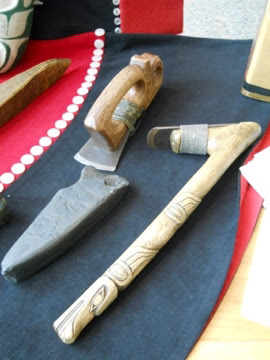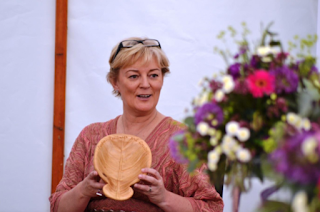The question was simple: did I think that a person with the use of only one hand could carve?
I sent a reply and, after some thought, realised that it may also be of interest to others who are temporarily or permanently in a similar situation. Although I currently have the use of both hands, I have experienced periods when injury has brought such considerations to mind.
The answer that I emailed back is reproduced in this post, with some alterations, extra images and information:
Can someone with the use of only one hand carve? My
answer is a very definite yes!
I'd
say that the question might be: what would you like to carve and
which tools and techniques will enable you to do it?
Some
techniques could be more difficult (such as using a gouge
and mallet) but many tools are traditionally used one-handed anyway.
Carvers in many parts of the world (including Africa and the
North-West Pacific Coast of the US and Canada) have been creating
huge, stunning pieces such as totem poles for many centuries by using adzes swung with one hand to do much of the work. Two types of adze used by
First Nations carvers in Canada are shown here, to the right and also
above the stone tool.
Adzes
require a bit of practise to wield accurately and can be quite hard
work to carve with for long periods of time if you aren't used to
using one. However, they are fundamental tools for carvers all over
the world and were also a vital piece of kit for most carvers and other
woodworkers in Europe for many centuries.
Reciprocating
(aka power) carvers are available that can be used one-handed. They
are a bit like an electric bread knife that a gouge or chisel
blade fits into the end of, which then moves back and forth very
quickly to enable easy cutting.
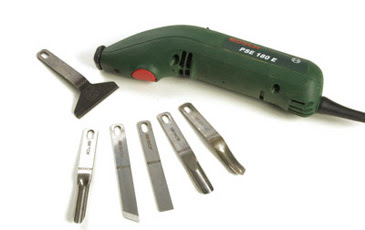 |
| Image from: http://www.woodworkersinstitute.com/wood-carving/kit-tools/power-tools/power-carvers/bosch-pse-180e/ |
I have one made by Bosch and I believe that Wecheer, Axminster and Proxxon also make them. They would be very useful for large and medium sized carvings. Blades made by Flexcut can be used with some of them by utilising adapters - some people find the range of Flexcut blades a bit more delicate and useful for carving with. If these tools are of interest to you, I'd really recommend buying an anti-vibration glove at the same time, as the vibrations when using these power carvers can be quite strong and could lead to 'white finger' nerve damage over time.
For
smaller scale work, I'd investigate rotary tools such as a Dremel or
Foredom tools. They are like small drills that can be fitted with
various shapes of cutter, including diamond ones for working on metal
and stone. They can also be fitted with long, flexible shafts to enable
more delicate handling of the cutters.
As
with any power carving tool, buy eye protection and ear defenders at
the same time if you don't already have them. If using these tools,
particularly with certain woods and stones, you'll also need to
consider wearing a dust mask and using dust extraction (a Henry vacuum cleaner has been known to work well - maybe with some kind of mesh over the nozzle to stop small workpieces disappearing inside!)
Another
range of tools worth looking at would be palm gouges and chisels.
They have rounded handles that sit comfortably in the palm of one
hand and aren't used with a mallet, so could be ideal. Very good ones
are made by the Swiss company Pfeil.
They aren't cheap, but they are usually excellent quality and are available in Britain.
Some
tools are also sold with a choice of either traditional handles or palm handles,
such as the 'RayGonzales hook skew'
made by Ashley Iles which is one of my go-to tools for many fine
carving cuts.
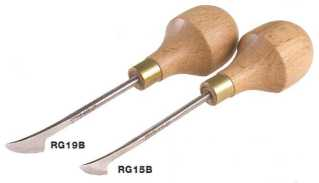 |
| Image from: http://www.ashleyiles.co.uk/ray_gonzalez_tool.html |
One question that will need thinking about is how work pieces will be held. As long as the workpiece is securely held all kinds of tools can be used on it, even a simple pocket knife. To be honest, it's the same question that any carver faces regularly when working on fiddly or awkwardly-shaped pieces!
I'd suggest
having a range of clamps, vices, wooden blocks and simple home-made frames that
can be used in different combinations to hold work.
One-handed 'quick' clamps similar to this one would be useful. They can be used relatively easily with one hand, but can easily work loose with repeated vibration from carving work so might need regular retightening.
 |
| Image from: http://www.irwin.co.uk/tools/clamps/quick-grip-medium-duty-one-handed-bar-clamps |
G-shaped cramps (a cramp works with a screw mechanism, a clamp doesn't) hold work more securely, but could perhaps be more fiddly to fit on when only using one hand.
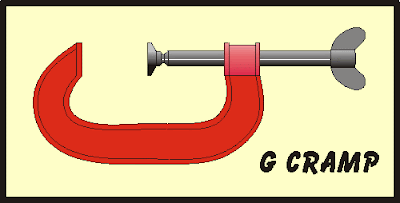 |
| Image from: http://wsdt.wellingboroughschool.org/resources/dtoncd1/school/cramps.html |
An interesting, simple method for holding sticks to be
whittled is shown on this blog. What
you need will depend entirely on what you're making, so perhaps start
trying to make things with an experimental and adaptable mindset and
evolve methods to hold your work as you go along.
One
place not to hold work is on your lap - slipping with the blade and
hitting one of the arteries running inside your thigh wouldn't be a
great way to finish your carving!
Another
place to get further info might be through the local occupational
therapy unit. They may well have ideas for techniques and devices
that could be adapted or repurposed to enable easier carving.
I
hope that this information is useful to you and encourages you to
give carving a go if you are considering trying it and have the use of one hand only.
If you have experienced carving one-handed and would like to comment or add to what has been written here, please do. I'd be very interested to hear other thoughts and ideas.
If you do decide to have a go at carving and make something that you
feel happy to share, please feel free to send me an image. I'd love to see what
you create!

